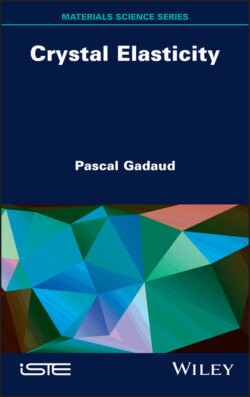Crystal Elasticity

Реклама. ООО «ЛитРес», ИНН: 7719571260.
Оглавление
Pascal Gadaud. Crystal Elasticity
Table of Contents
List of Tables
List of Illustrations
Guide
Pages
Crystal Elasticity
Introduction
1. Macroscopic Elasticity: Conventional Writing
1.1. Generalized Hooke’s law
1.1.1. Cubic symmetry
1.1.2. Hexagonal symmetry
1.2. Theory and experimental precautions
2. Macroscopic Elasticity: Dimensionless Representation and Simplification
2.1. Cubic symmetry: cc and fcc metals
2.2. Hexagonal symmetry
2.3. Other symmetries
2.4. Problem posed by cubic sub-symmetries
3. Crystal Elasticity: From Monocrystal to Lattice
3.1. Discrete representation
3.2. Continuous representation for cubic symmetry
3.3. Continuous representation for the hexagonal symmetry
4. Macroscopic Elasticity: From Monocrystal to Polycrystal
4.1. Homogenization: several historical approaches and a simplified approach
4.2. Choice of “ideal” data sets and comparison of various approaches
4.3. Two-phase materials, inverse problem and textured polycrystals. 4.3.1. Two-phase materials
4.3.2. Reverse problem
4.3.3. Textured materials
5. Experimental Macroscopic Elasticity: Relation with Structural Aspects and Physical Properties
5.1. A high-performance experimental method
5.2. Elasticity of nickel-based superalloys
5.2.1. Single-grained superalloy
5.2.2. Passage from cubic symmetry to transverse isotropic symmetry
5.2.3. Rafting
5.2.4. Precipitation in Inconel 718
5.3. Elasticity and physical properties
5.3.1. Phase transformations
5.3.2. Magneto-elasticity
5.3.3. Ferroelectricity and phase transformation
5.4. Influence of porosity and damage on elasticity. 5.4.1. Isotropic porosity
5.4.2. Anisotropic porosity
5.4.3. Micro-cracks and extreme porosity
5.5. The mystery of the diamond structure
5.6. What about amorphous materials?
5.7. Inelasticity and fine structure of crystals
5.7.1. Relaxation of substitutional defects
5.7.2. Relaxation of interstitial defects
Introduction to Part 2
6. Tension–Compression in a Cylindrical Rod. 6.1. Tension–compression without transverse deformation
6.2. Tension–compression with transverse deformation
6.3. Determination of E and ν of isotropic and anisotropic materials
7. Beam Bending. 7.1. Homogeneous beam bending without shear
7.2. Homogeneous beam bending with shear. 7.2.1. Homogeneous beam bending with shear (rotation)
7.2.2. Homogeneous beam bending with shear (deformation)
7.2.3. Homogeneous beam bending with shear (comparison)
7.3. Application to the characterization of the elasticity of bulk materials
7.4. Composite beam bending (substrate + coating)
7.5. Composite beam bending (substrate + “sandwich” coating)
7.6. Application to the characterization of single coatings
7.7. Three-layer beam bending
7.8. Multi-layered and with gradient in elastic properties of materials
8. Plate Torsion
8.1 Torsion of homogeneous cylinder
8.2. Torsion of homogeneous plate
8.3. Determination of the shear modulus and Poisson’s ratio for bulk materials
8.4. Torsion of composite plate
9. Thin Plate Bending
9.1. Bending vibrations of a homogeneous thin plate
9.2. Application to the characterization of thin plate elasticity
10. Vibration Measurements and Macroscopic Internal Stresses
10.1. Experimental evidence of the relaxation of the internal stresses of bulk materials
10.2. Internal stresses and homogeneous beam vibration
10.3. Analysis of the profile of internal stresses of coated materials (static case)
10.3.1. Analysis of the profile of symmetric double coating stresses
10.3.2. Analysis of the profile of single coating stresses
10.4. Influence of internal stresses on the vibrations of coated materials. 10.4.1. Influence of internal stresses on the vibrations of coated materials in sandwich configuration
10.4.2. Influence of internal stresses on the vibrations of coated materials in single coating configuration
10.5. Application to the determination of internal stresses of coated materials
Conclusion
References
Index
WILEY END USER LICENSE AGREEMENT
Отрывок из книги
to Philippe M.†for having conveyed to me histaste for experimental work andhopefully some of his skill
.....
[1.31]
[1.32]
.....